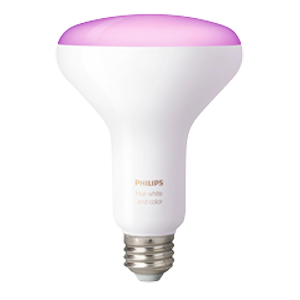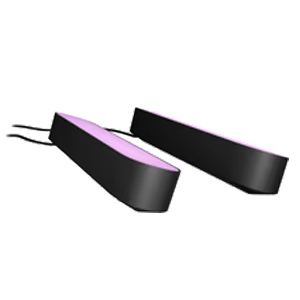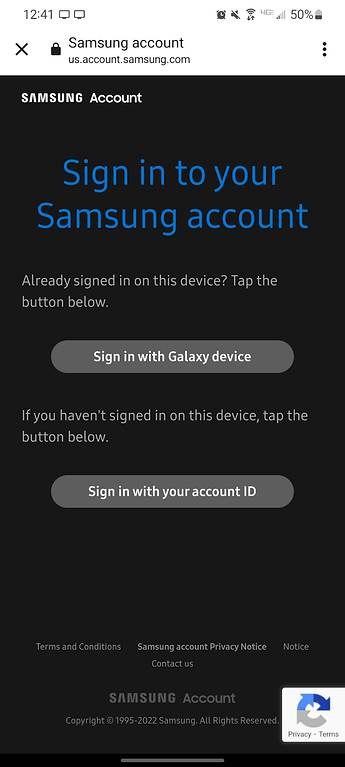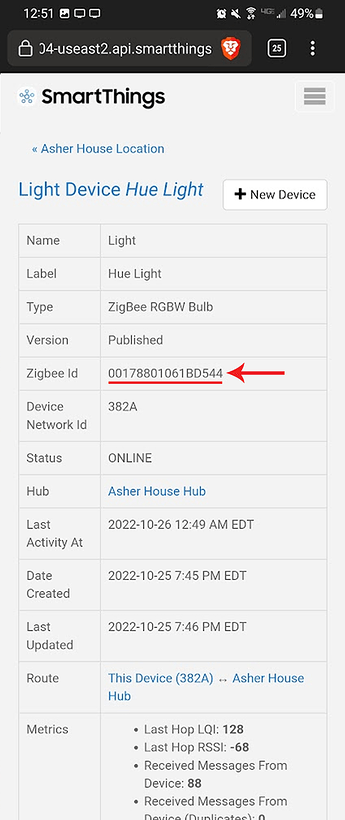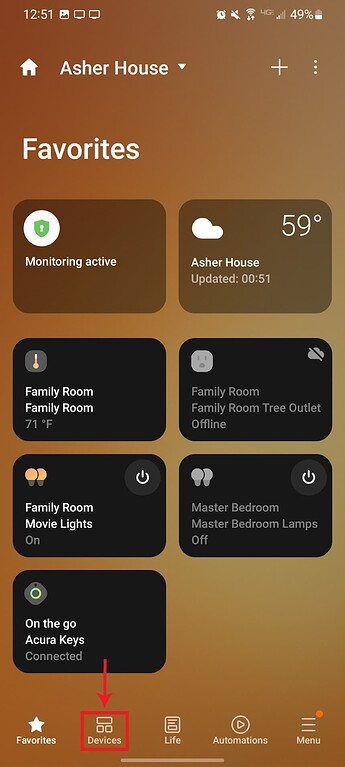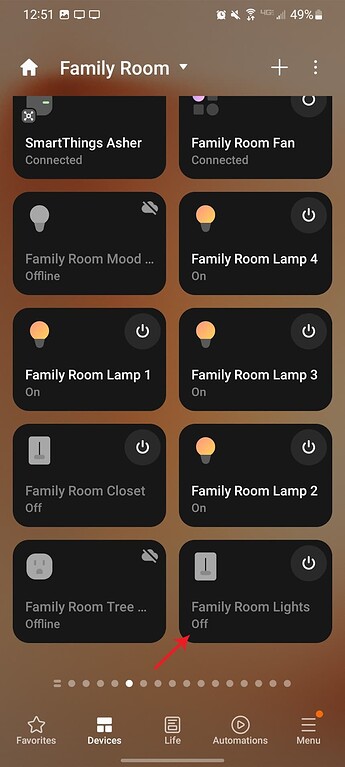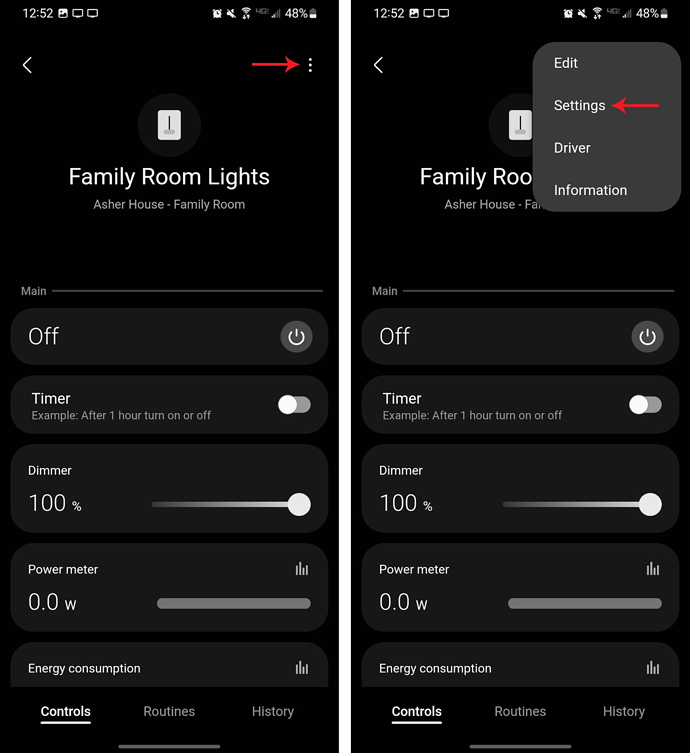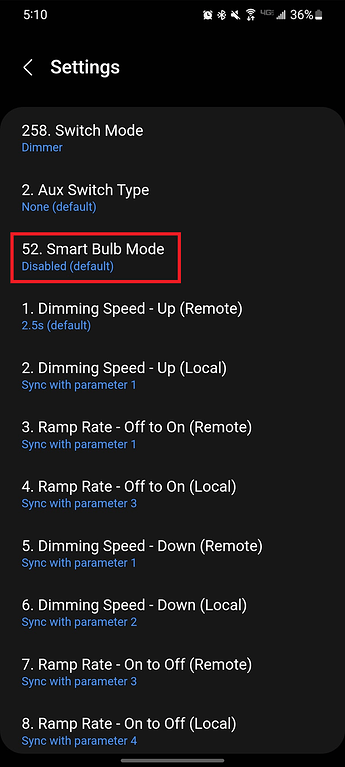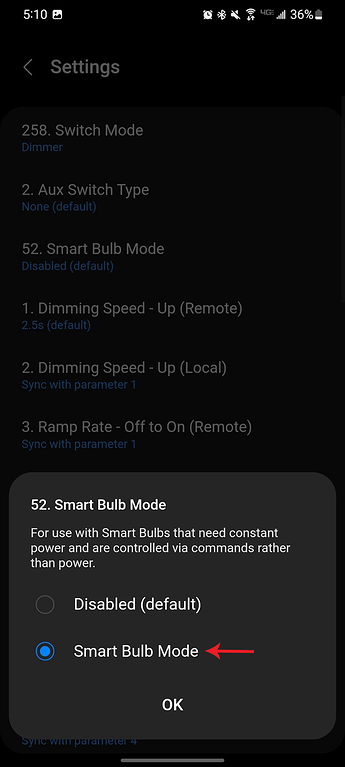DISCLAIMER
While we (and our community) try to keep these instructions up to date, it’s often hard due to the many updates to our firmware, SmartThings app & platform changes, as well as many other factors outside of our control. If any updates/edits need to be made to these instructions, please comment on this thread so we can keep it up-to-date:Wiki - General Feedback/Suggestions Thread
COMMUNITY DRIVEN
Our entire Knowledge Base (which includes manuals) is community driven. This means that we at Inovelli work together with our amazing community to keep articles up-to-date. We’d love it if you’d contribute in any way you can, be it making edits, submitting how-to’s so others can learn, participating in our innovation projects, or simply commenting on threads. Thank you so much for your support and dedication to really making an impact in the smart home market.Community Knowledge Base
NOTE: All of the pictures can be clicked on to be made larger. Also, if you’re on mobile, you can either click on the pictures or turn your phone side-ways and the pictures will become larger.
Zigbee Binding Overview
Zigbee binding is when two or more Zigbee products communicate directly with one another without the need to communicate with a hub. There are two main benefits of utilizing Zigbee binding: speed & local control.
From a speed standpoint, cutting out the middle-man (hub) can save precious milliseconds or even seconds depending on your cloud and/or processing power off your hub. Whereas from a local control standpoint, if your hub goes does down and cannot communicate, your products can still talk to each other.
Below is a quick video that shows the speed of Zigbee Bindings:
NOTE: The above video is using Home Assistant via ZHA (however, the speed is identical using SmartThings).
For an official explanation, please see this link: Zigbee Bindings
Navigating these Instructions
For desktop users, the, “Table of Contents” is located to the right of the screen, whereas for mobile users, it can be found at the bottom of the screen.
NOTE: If you do not see the table of contents, click here: How To's | Setup Zigbee Binding - SmartThings
Please click on any of the sections to get started. We recommend working your way down as it follows an intentional flow that is user friendly and hub/gateway specific.
Prerequisites
There are three prerequisites to setting up Zigbee bindings with your Inovelli Switch in SmartThings and they are:
- Ensure what you’re binding to your switch is Zigbee and supports Zigbee binding
- Your Inovelli switch is using an Edge Driver
- The product your binding to is using an Edge Driver
NOTE: If you are binding a Blue Series Switch to a Philips Hue bulb, you will need the Hue bulb to be paired directly to the SmartThings hub (ie: it cannot be paired to the Philips Hue bridge). Zigbee bindings only work if each Zigbee device is on the same hub.
Compatible Products
We’ve tested Zigbee binding with the following Zigbee products on our switches:
DISCLAIMER: As an Amazon Associate Inovelli, LLC earns from qualifying purchases.
Edge Driver Check
Before we get into setting up the bindings we need to make sure that your Inovelli switch is using the Inovelli Edge Driver (it should by default be picked up when you paired your device, but SmartThings is going through a transition right now so it may not have). It will make it easier if the device you’re binding to the Inovelli device is also using an Edge Driver, but it can be done without one.
NOTE: SmartThings will be moving everything to an Edge Driver soon, so the method used for devices without an Edge Driver will be soon outdated.
The quick and easy way to determine whether or not your devices are using an Edge Driver is to do the following:
- Open up your SmartThings App and click on, “Devices” at the bottom
- Search for the device you want to check and click on it
- Click on the three dots at the top right and look to see whether or not it says, “Driver” (if it does, then your device is using an Edge Driver)
Edge Driver Installation
In an effort to keep directions consolidated into one area, please see the, “SmartThings Edge Driver Installation” page for instructions on how to install the Edge Driver for your Inovelli device.
For non-Inovelli devices, please reach out to SmartThings support, the device manufacturer, or comment in either the SmartThings or the Inovelli community for advice. As of January 2023, most devices have transitioned over to some sort of Edge Driver, but it’s best to check with the manufacturer as to which Driver you should use.
Setup Instructions
Below we will walk through a few different scenarios where you’d want to use Zigbee binding: Switch to Bulb, Switch to Switch and Switch to Switch & Bulb.
Switch to Bulb(s)
In this scenario, you will be binding your Inovelli switch to Zigbee bulb(s). Please click on the drop-downs to select the option that best suits your setup.
Smart Bulb(s) Wired to Smart Switch
Please select from the following drop-downs based on the number of smart bulbs you have:
Smart Switch to 1x Smart Bulb
In this example, we will use the combination of Smart Bulb Mode (to keep full power to your smart bulbs) plus Zigbee Binding.
Feel free to follow the written instructions below by clicking the drop downs:
Written Instructions
This part is broken into two sections: Getting the Zigbee ID and Zigbee BindingGetting the Zigbee ID
In order to bind the Zigbee devices together, we need to identify which devices will be bound together. To do this, we need to get the Zigbee ID’s. SmartThings does not have an easy way to do this, so apologies for the extra steps. In addition, there are two ways to accomplish this – please select the dropdown that aligns to your situation.
Remember to check first to see whether or not the smart bulb is using an Edge Driver or not (if the bulb does use an Edge Driver, please use the Edge Driver instructions – if not, use the Device Handler instructions). Instructions to check are here: Edge Driver Check
Smart Bulb is using an Edge Driver
- First, we’ll need to create a SmartThings Access Token so that we can ultimately find the smart bulb(s) information – head to the following link and login: SmartThings Access Token—
- Enter in a Token Name, select everything in the sections titled, “Devices” and “Locations” and then click, “Generate Token”—
- WRITE DOWN THE TOKEN AND SAVE IT!!! You will not be able to access this token again so you want to make sure you have it for future reference. Click on, “Copy token” move to Step 4.—
- Once you have the token saved in a secure place and copied to your clipboard, please go to the following URL, enter the access token and click, “Submit” (you should see your hub location and the various rooms you’ve created in the SmartThings app): ST Device Info Viewer—
- Find your device and click on the, “i” —
- Locate where it says, “eui” and copy the 16 digit code (Zigbee ID)—
Smart Bulb is using a Device Handler (DTH)
- First, we’ll need login to SmartThings IDE, which can be found here: SmartThings IDE—
- Click on, “Devices” (if no devices show up, you may need to click on, “Locations” and then click on your Hub – then click, “Devices”), find your device and click on it—
- Scroll to where it says, “Zigbee Id” and copy the ID (should be 16 characters)—
Zigbee Binding
Now we will bind your switch to your smart bulb. In this example, we will assume the smart bulb is the load on your smart switch (ie: the bulb socket is wired directly to your switch) – and because of this assumption, we will also use Smart Bulb Mode (which provides constant power to your smart bulb and uses a digital signal to turn it on and off – in this case Zigbee binding).
Reminder: You need to have the Edge Driver installed on your Inovelli switch.
Written Instructions
- Open up your SmartThings app, and click on, “Devices”—
- Locate your Inovelli switch and click on it—
- Click on the three dots at the top right and select, “Settings”—
- Scroll down to where it says, “52. Smart Bulb Mode” and select it—
- Click on, “Smart Bulb Mode” and then “OK”—
- Scroll down to the bottom where it says, “Bind # 1, Bind #2, etc.”—
Picture Visual
- Click on, “Bind # X where X is the first available binding slot”, enter in the device eui, a “/” slash, and the endpoint (exactly as shown in the example) , “Save”(for Philips Hue enter 11, for all others enter 1 – if it doesn’t work, please reach out to let us know the bulb make/model and we will try to figure out the endpoint)
Picture Visual

If you’d like to control the colors from the switch (ie: double-tap to change the bulb to blue, triple-tap to change the bulb to red, etc), check out the instructions for Scene Control.
Smart Switch to Multiple Smart Bulbs
In this example, we will use the combination of Smart Bulb Mode (to keep full power to your smart bulbs) plus Zigbee Binding.
Feel free to follow the written instructions below by clicking the drop downs:
Written Instructions
This part is broken into two sections: Getting the Zigbee ID and Zigbee BindingGetting the Zigbee ID
In order to bind the Zigbee devices together, we need to identify which devices will be bound together. To do this, we need to get the Zigbee ID’s. SmartThings does not have an easy way to do this, so apologies for the extra steps. In addition, there are two ways to accomplish this – please select the dropdown that aligns to your situation.
Remember to check first to see whether or not the smart bulb is using an Edge Driver or not (if the bulb does use an Edge Driver, please use the Edge Driver instructions – if not, use the Device Handler instructions). Instructions to check are here: Edge Driver Check
Smart Bulb is using an Edge Driver
- First, we’ll need to create a SmartThings Access Token so that we can ultimately find the smart bulb(s) information – head to the following link and login: SmartThings Access Token—
- Enter in a Token Name, select everything in the sections titled, “Devices” and “Locations” and then click, “Generate Token”—
- WRITE DOWN THE TOKEN AND SAVE IT!!! You will not be able to access this token again so you want to make sure you have it for future reference. Click on, “Copy token” move to Step 4.—
- Once you have the token saved in a secure place and copied to your clipboard, please go to the following URL, enter the access token and click, “Submit” (you should see your hub location and the various rooms you’ve created in the SmartThings app): ST Device Info Viewer—
- Find your device(s) and click on the, “i” —
- Locate where it says, “eui” and copy the 16 digit code (Zigbee ID)—
- Repeat steps 5-6 for each bulb you have and write down the Zigbee ID for each.
Smart Bulb is using a Device Handler (DTH)
- First, we’ll need login to SmartThings IDE, which can be found here: SmartThings IDE—
- Click on, “Devices” (if no devices show up, you may need to click on, “Locations” and then click on your Hub – then click, “Devices”), find your device and click on it—
- Scroll to where it says, “Zigbee Id” and copy the ID (should be 16 characters)—
- Repeat steps 2-3 for each bulb you have and write down the Zigbee ID for each.
Zigbee Binding
Now we will bind your switch to your smart bulbs. In this example, we will assume the smart bulbs are on the load on your smart switch (ie: the bulb socket is wired directly to your switch) – and because of this assumption, we will also use Smart Bulb Mode (which provides constant power to your smart bulb and uses a digital signal to turn it on and off – in this case Zigbee binding). If your smart bulb(s) are not part of your switches load, you may skip steps 4-5.
Reminder: You need to have the Edge Driver installed on your Inovelli switch.
Written Instructions
- Open up your SmartThings app, and click on, “Devices”—
- Locate your Inovelli switch and click on it—
- Click on the three dots at the top right and select, “Settings”—
- Scroll down to where it says, “52. Smart Bulb Mode” and select it—
- Click on, “Smart Bulb Mode” and then “OK”—
- Scroll down to the bottom where it says, “Bind # 1, Bind #2, etc.”—
Picture Visual
- Click on, “Bind # X where X is the first available binding slot”, enter in the device eui, a “/” slash, and the endpoint (exactly as shown in the example) , “Save”(for Philips Hue enter 11, for all others enter 1 – if it doesn’t work, please reach out to let us know the bulb make/model and we will try to figure out the endpoint)
Picture Visual

If you’d like to control the colors from the switch (ie: double-tap to change the bulb to blue, triple-tap to change the bulb to red, etc), check out the instructions for Scene Control.
Smart Bulb(s) NOT Wired to Smart Switch
Please select from the following drop-downs based on the number of smart bulbs you have:
Smart Switch to 1x Smart Bulb
In this example, we will use Zigbee Binding to bind your switch to your smart bulb when your bulb is not the switches load (ie: the bulb socket is not wired directly to the switch). If your bulb socket is wired directly to your switch, please scroll up to the section titled, “Smart Bulb(s) Wired to Smart Switch” as you will need to use Smart Bulb Mode.
Feel free to follow the written instructions below by clicking the drop downs:
Written Instructions
This part is broken into two sections: Getting the Zigbee ID and Zigbee BindingGetting the Zigbee ID
In order to bind the Zigbee devices together, we need to identify which devices will be bound together. To do this, we need to get the Zigbee ID’s. SmartThings does not have an easy way to do this, so apologies for the extra steps. In addition, there are two ways to accomplish this – please select the dropdown that aligns to your situation.
Remember to check first to see whether or not the smart bulb is using an Edge Driver or not (if the bulb does use an Edge Driver, please use the Edge Driver instructions – if not, use the Device Handler instructions). Instructions to check are here: Edge Driver Check
Smart Bulb is using an Edge Driver
- First, we’ll need to create a SmartThings Access Token so that we can ultimately find the smart bulb(s) information – head to the following link and login: SmartThings Access Token—
- Enter in a Token Name, select everything in the sections titled, “Devices” and “Locations” and then click, “Generate Token”—
- WRITE DOWN THE TOKEN AND SAVE IT!!! You will not be able to access this token again so you want to make sure you have it for future reference. Click on, “Copy token” move to Step 4.—
- Once you have the token saved in a secure place and copied to your clipboard, please go to the following URL, enter the access token and click, “Submit” (you should see your hub location and the various rooms you’ve created in the SmartThings app): ST Device Info Viewer—
- Find your device and click on the, “i” —
- Locate where it says, “eui” and copy the 16 digit code (Zigbee ID)—
Smart Bulb is using a Device Handler (DTH)
- First, we’ll need login to SmartThings IDE, which can be found here: SmartThings IDE—
- Click on, “Devices” (if no devices show up, you may need to click on, “Locations” and then click on your Hub – then click, “Devices”), find your device and click on it—
- Scroll to where it says, “Zigbee Id” and copy the ID (should be 16 characters)—
Zigbee Binding
Now we will bind your switch to your smart bulb. In this example, we will assume the smart bulb is not the load on your smart switch (ie: the bulb socket is not wired directly to your switch) – and because of this assumption, we will not use Smart Bulb Mode (which provides constant power to your smart bulb and uses a digital signal to turn it on and off – in this case Zigbee binding). If your switch is wired directly to your smart bulbs, then please go to the section titled, “Smart Bulb(s) Wired to Smart Switch”.
Reminder: You need to have the Edge Driver installed on your Inovelli switch.
Written Instructions
- Open up your SmartThings app, and click on, “Devices”—
- Locate your Inovelli switch and click on it—
- Click on the three dots at the top right and select, “Settings”—
- Scroll down to the bottom where it says, “Bind # 1, Bind #2, etc.”—
Picture Visual
- Click on, “Bind # X where X is the first available binding slot”, enter in the device eui, a “/” slash, and the endpoint (exactly as shown in the example) , “Save”(for Philips Hue enter 11, for all others enter 1 – if it doesn’t work, please reach out to let us know the bulb make/model and we will try to figure out the endpoint)
Picture Visual

If you’d like to control the colors from the switch (ie: double-tap to change the bulb to blue, triple-tap to change the bulb to red, etc), check out the instructions for Scene Control.
Smart Switch to Multiple Smart Bulbs
In this example, we will use Zigbee Binding to bind your switch to your smart bulbs when your bulbs are not on the switches load (ie: the bulb socket is not wired directly to the switch). If your bulb sockets are wired directly to your switch, please scroll up to the section titled, “Smart Bulb(s) Wired to Smart Switch” as you will need to use Smart Bulb Mode.
Feel free to follow the written instructions below by clicking the drop downs:
Written Instructions
This part is broken into two sections: Getting the Zigbee ID and Zigbee BindingGetting the Zigbee ID
In order to bind the Zigbee devices together, we need to identify which devices will be bound together. To do this, we need to get the Zigbee ID’s. SmartThings does not have an easy way to do this, so apologies for the extra steps. In addition, there are two ways to accomplish this – please select the dropdown that aligns to your situation.
Remember to check first to see whether or not the smart bulb is using an Edge Driver or not (if the bulb does use an Edge Driver, please use the Edge Driver instructions – if not, use the Device Handler instructions). Instructions to check are here: Edge Driver Check
Smart Bulb is using an Edge Driver
- First, we’ll need to create a SmartThings Access Token so that we can ultimately find the smart bulb(s) information – head to the following link and login: SmartThings Access Token—
- Enter in a Token Name, select everything in the sections titled, “Devices” and “Locations” and then click, “Generate Token”—
- WRITE DOWN THE TOKEN AND SAVE IT!!! You will not be able to access this token again so you want to make sure you have it for future reference. Click on, “Copy token” move to Step 4.—
- Once you have the token saved in a secure place and copied to your clipboard, please go to the following URL, enter the access token and click, “Submit” (you should see your hub location and the various rooms you’ve created in the SmartThings app): ST Device Info Viewer—
- Find your device(s) and click on the, “i” —
- Locate where it says, “eui” and copy the 16 digit code (Zigbee ID)—
- Repeat steps 5-6 for each bulb you have and write down the Zigbee ID for each.
Smart Bulb is using a Device Handler (DTH)
- First, we’ll need login to SmartThings IDE, which can be found here: SmartThings IDE—
- Click on, “Devices” (if no devices show up, you may need to click on, “Locations” and then click on your Hub – then click, “Devices”), find your device and click on it—
- Scroll to where it says, “Zigbee Id” and copy the ID (should be 16 characters)—
- Repeat steps 2-3 for each bulb you have and write down the Zigbee ID for each.
Zigbee Binding
Now we will bind your switch to your smart bulbs. In this example, we will assume the smart bulbs are not on the load on your smart switch (ie: the bulb sockets are not wired directly to your switch) – and because of this assumption, we will not use Smart Bulb Mode (which provides constant power to your smart bulb and uses a digital signal to turn it on and off – in this case Zigbee binding). If your smart bulbs are wired directly to the smart switch, please go to the section titled, “Smart Bulb(s) Wired to Smart Switch”.
Reminder: You need to have the Edge Driver installed on your Inovelli switch.
Written Instructions
- Open up your SmartThings app, and click on, “Devices”—
- Locate your Inovelli switch and click on it—
- Click on the three dots at the top right and select, “Settings”—
- Scroll down to the bottom where it says, “Bind # 1, Bind #2, etc.”—
Picture Visual
- Click on, “Bind # X where X is the first available binding slot”, enter in the device eui, a “/” slash, and the endpoint (exactly as shown in the example) , “Save”(for Philips Hue enter 11, for all others enter 1 – if it doesn’t work, please reach out to let us know the bulb make/model and we will try to figure out the endpoint)
Picture Visual

If you’d like to control the colors from the switch (ie: double-tap to change the bulb to blue, triple-tap to change the bulb to red, etc), check out the instructions for Scene Control.
Switch to Switch(es)
In this scenario, you will be binding your Inovelli switch to another Inovelli switch (or switches). Please click on the drop-downs to select the option that best suits your setup.
2x Smart Switches (ie: Switch to Switch)
Written Instructions
This part is broken into two sections: Getting the Zigbee ID and Zigbee Binding
Getting the Zigbee ID
In order to bind the Zigbee devices together, we need to identify which devices will be bound together. To do this, we need to get the Zigbee ID’s. SmartThings does not have an easy way to do this, so apologies for the extra steps.
Written Instructions
- First, we’ll need to create a SmartThings Access Token so that we can ultimately find the smart switch(es) information – head to the following link and login: SmartThings Access Token—
- Enter in a Token Name, select everything in the sections titled, “Devices” and “Locations” and then click, “Generate Token”—
- WRITE DOWN THE TOKEN AND SAVE IT!!! You will not be able to access this token again so you want to make sure you have it for future reference. Click on, “Copy token” move to Step 4.—
- Once you have the token saved in a secure place and copied to your clipboard, please go to the following URL, enter the access token and click, “Submit” (you should see your hub location and the various rooms you’ve created in the SmartThings app): ST Device Info Viewer—
- Find your device(s) and click on the, “i” —
- Locate where it says, “eui” and copy the 16 digit code (Zigbee ID)—
- Repeat steps 5-6 for each switch you have and write down the Zigbee ID for each.
Zigbee Binding
Now we will bind your switches together. Reminder: You need to have the Edge Driver installed on your Inovelli switches.
Written Instructions
- Open up your SmartThings app, and click on, “Devices”—
- Locate your Inovelli switch (Switch #1) and click on it—
- Click on the three dots at the top right and select, “Settings”—
- Scroll down to the bottom where it says, “Bind # 1, Bind #2, etc.”—
Picture Visual
- Click on, “Bind # X where X is the first available binding slot”, enter in the device eui, a “/” slash, and the endpoint (exactly as shown in the example) , “Save”(for Philips Hue enter 11, for all others enter 1 – if it doesn’t work, please reach out to let us know the bulb make/model and we will try to figure out the endpoint)
Picture Visual

3+ Smart Switches (ie: Switch to Multiple Switches)
In this example, we will be binding three or more Inovelli switches together. As a reminder, if you do not have the Edge Driver installed, please follow the instructions here before proceeding below: Installing the Edge Driver
To give a visual of what we’ll be doing, we will be doing the following:
Essentially we are forward / backward binding each switch to one another so that no matter what switch you press, all of them will turn on and match.
Feel free to follow the written instructions below by clicking the drop down:
Written Instructions
This part is broken into two sections: Getting the Zigbee ID and Zigbee BindingGetting the Zigbee ID
In order to bind the Zigbee devices together, we need to identify which devices will be bound together. To do this, we need to get the Zigbee ID’s. SmartThings does not have an easy way to do this, so apologies for the extra steps.
Written Instructions
- First, we’ll need to create a SmartThings Access Token so that we can ultimately find the smart switch(es) information – head to the following link and login: SmartThings Access Token—
- Enter in a Token Name, select everything in the sections titled, “Devices” and “Locations” and then click, “Generate Token”—
- WRITE DOWN THE TOKEN AND SAVE IT!!! You will not be able to access this token again so you want to make sure you have it for future reference. Click on, “Copy token” move to Step 4.—
- Once you have the token saved in a secure place and copied to your clipboard, please go to the following URL, enter the access token and click, “Submit” (you should see your hub location and the various rooms you’ve created in the SmartThings app): ST Device Info Viewer—
- Find your device(s) and click on the, “i” —
- Locate where it says, “eui” and copy the 16 digit code (Zigbee ID)—
- Repeat steps 5-6 for each switch you have and write down the Zigbee ID for each.
Zigbee Binding
Now we will bind your switches together. Reminder: You need to have the Edge Driver installed on your Inovelli switches.
Written Instructions
Referring to the diagram above, you will have to set up six (6) different bindings:
- Switch #1 - Bound to Switch #2 and Switch #3
- Switch #2 - Bound to Switch #1 and Switch #3
- Switch #3 - Bound to Switch #1 and Switch #2
We’ll go through one example below (binding Switch #1 to Switch #2 and Switch #3) to show you the process. Then you’ll just repeat this process for Switch #2 and Switch #3 (and any more switches you may have). Feel free to use the diagram above as a cheat-sheet.
- Open up your SmartThings app, and click on, “Devices”—
- Locate your Inovelli switch (Switch #1) and click on it—
- Click on the three dots at the top right and select, “Settings”—
- Scroll down to the bottom where it says, “Bind # 1, Bind #2, etc.”—
Picture Visual
- Click on, “Bind # X where X is the first available binding slot”, enter in the device eui, a “/” slash, and the endpoint (exactly as shown in the example) , “Save”(for Philips Hue enter 11, for all others enter 1 – if it doesn’t work, please reach out to let us know the bulb make/model and we will try to figure out the endpoint)
Picture Visual

Switch to Switch(es) & Bulb(s)
In this scenario, you will be binding your Inovelli switch to another Inovelli switch (or switches) and Zigbee bulb(s). Please click on the drop-downs to select the option that best suits your setup.
Smart Switches + Smart Bulb(s) Wired to Smart Switch
Written Instructions
This part is broken into two sections: Getting the Zigbee ID and Zigbee Binding
Getting the Zigbee ID
In order to bind the Zigbee devices together, we need to identify which devices will be bound together. To do this, we need to get the Zigbee ID’s. SmartThings does not have an easy way to do this, so apologies for the extra steps.
Written Instructions
- First, we’ll need to create a SmartThings Access Token so that we can ultimately find the smart switch(es)/bulb(s) information – head to the following link and login: SmartThings Access Token—
- Enter in a Token Name, select everything in the sections titled, “Devices” and “Locations” and then click, “Generate Token”—
- WRITE DOWN THE TOKEN AND SAVE IT!!! You will not be able to access this token again so you want to make sure you have it for future reference. Click on, “Copy token” move to Step 4.—
- Once you have the token saved in a secure place and copied to your clipboard, please go to the following URL, enter the access token and click, “Submit” (you should see your hub location and the various rooms you’ve created in the SmartThings app): ST Device Info Viewer—
- Find your device(s) and click on the, “i” —
- Locate where it says, “eui” and copy the 16 digit code (Zigbee ID)—
- Repeat steps 5-6 for each switch you have and write down the Zigbee ID for each.
Zigbee Binding
In this example, we will use the combination of Smart Bulb Mode (to keep full power to your smart bulbs) plus Zigbee Binding.
This will get semi-complicated because you have to setup various bindings. To keep it simple, remember the following:
- Bind your switches to each other (forward and backward)
- If you have two (2) switches, you’ll want to bind Switch #1 to Switch #2, then create another binding of Switch #2 to Switch #1
- If you have three (3+) or more switches, you’ll want to bind Switch #1 to Switch #2 and Switch #3, then create another binding of Switch #2 to Switch #1 and Switch #3 and a final binding of Switch #3 to Switch #1 and Switch #2
- For bulbs, you can only forward bind (Inovelli to Bulb) as we do not have Edge Drivers for other manufacturers.
- If you have one (1) bulb, you’ll bind Switch #1 to Bulb #1, then create another binding of Switch #2 to Bulb #1
- If you have more than one bulb (2+), you’ll bind Switch #1 to Bulb #1 and Bulb #2, then create another binding of Switch #2 to Bulb #1 and Bulb #2
Feel free to follow the written instructions below by clicking the drop downs. Reminder: You need to have the Edge Driver installed on your Inovelli switches.
Written Instructions
In the example below, we will show you how to bind 2x switches to 2x bulbs. Keep the pointers in mind that were listed above this if you have more or less switches or bulbs.
- Open up your SmartThings app, and click on, “Devices”—
- Locate your Inovelli switch (Switch #1) and click on it—
- Click on the three dots at the top right and select, “Settings”—
- Scroll down to where it says, “52. Smart Bulb Mode” and select it—
- Click on, “Smart Bulb Mode” and then “OK”—
- Scroll down to the bottom where it says, “Bind # 1, Bind #2, etc.”—
Picture Visual
- Click on, “Bind # X where X is the first available binding slot”, enter in the device eui, a “/” slash, and the endpoint (exactly as shown in the example) , “Save”(for Philips Hue enter 11, for all others enter 1 – if it doesn’t work, please reach out to let us know the bulb make/model and we will try to figure out the endpoint)
Picture Visual

Smart Switches + Smart Bulb(s) NOT Wired to Smart Switch
Written Instructions
This part is broken into two sections: Getting the Zigbee ID and Zigbee Binding
Getting the Zigbee ID
In order to bind the Zigbee devices together, we need to identify which devices will be bound together. To do this, we need to get the Zigbee ID’s. SmartThings does not have an easy way to do this, so apologies for the extra steps.
Written Instructions
- First, we’ll need to create a SmartThings Access Token so that we can ultimately find the smart switch(es)/bulb(s) information – head to the following link and login: SmartThings Access Token—
- Enter in a Token Name, select everything in the sections titled, “Devices” and “Locations” and then click, “Generate Token”—
- WRITE DOWN THE TOKEN AND SAVE IT!!! You will not be able to access this token again so you want to make sure you have it for future reference. Click on, “Copy token” move to Step 4.—
- Once you have the token saved in a secure place and copied to your clipboard, please go to the following URL, enter the access token and click, “Submit” (you should see your hub location and the various rooms you’ve created in the SmartThings app): ST Device Info Viewer—
- Find your device(s) and click on the, “i” —
- Locate where it says, “eui” and copy the 16 digit code (Zigbee ID)—
- Repeat steps 5-6 for each switch you have and write down the Zigbee ID for each.
Zigbee Binding
This will get semi-complicated because you have to setup various bindings. To keep it simple, remember the following:
- Bind your switches to each other (forward and backward)
- If you have two (2) switches, you’ll want to bind Switch #1 to Switch #2, then create another binding of Switch #2 to Switch #1
- If you have three (3+) or more switches, you’ll want to bind Switch #1 to Switch #2 and Switch #3, then create another binding of Switch #2 to Switch #1 and Switch #3 and a final binding of Switch #3 to Switch #1 and Switch #2
- For bulbs, you can only forward bind (Inovelli to Bulb) as we do not have Edge Drivers for other manufacturers.
- If you have one (1) bulb, you’ll bind Switch #1 to Bulb #1, then create another binding of Switch #2 to Bulb #1
- If you have more than one bulb (2+), you’ll bind Switch #1 to Bulb #1 and Bulb #2, then create another binding of Switch #2 to Bulb #1 and Bulb #2
Feel free to follow the written instructions below by clicking the drop downs. Reminder: You need to have the Edge Driver installed on your Inovelli switches.
Written Instructions
In the example below, we will show you how to bind 2x switches to 2x bulbs. Keep the pointers in mind that were listed above this if you have more or less switches or bulbs.
- Open up your SmartThings app, and click on, “Devices”—
- Locate your Inovelli switch (Switch #1) and click on it—
- Click on the three dots at the top right and select, “Settings”—
- Scroll down to the bottom where it says, “Bind # 1, Bind #2, etc.”—
Picture Visual
- Click on, “Bind # X where X is the first available binding slot”, enter in the device eui, a “/” slash, and the endpoint (exactly as shown in the example) , “Save”(for Philips Hue enter 11, for all others enter 1 – if it doesn’t work, please reach out to let us know the bulb make/model and we will try to figure out the endpoint)
Picture Visual

See a Mistake?
If you see a mistake and would like to report it, please comment on the feedback thread or send a message to our support team.
Hub instructions can quickly become outdated and we rely on the community to let us know if something is wrong so we can quickly update it. Thanks so much for your support!




